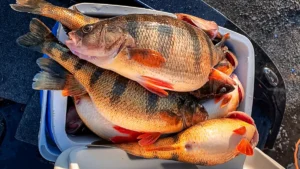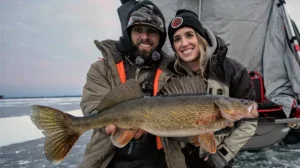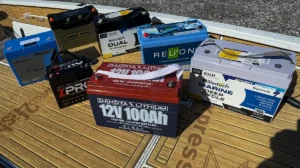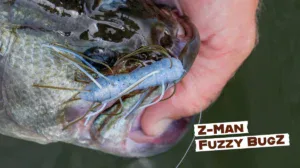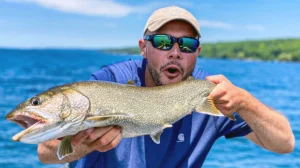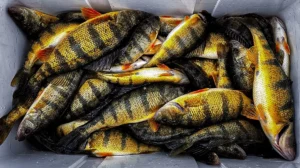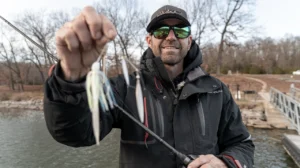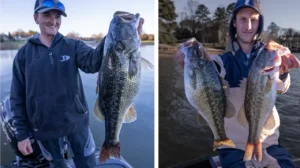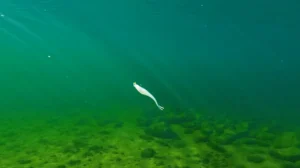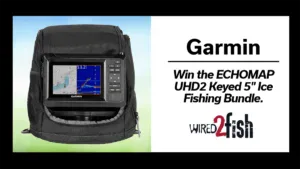Once the water reaches around 70 degrees and the bass finish spawning, the shad begin their spawn. This becomes a prime feeding window for bass wanting to take advantage of this easy meal before transitioning into their summer locations.
Shad spawns tend to happen first thing in the morning and can lead to some really productive days on the water. However, there is a little more to catching these bass than just finding the shad. Here are a few tips that will help you locate and capitalize on the most productive shad spawns on your body of water.
Most Productive Areas to find a Shad Spawns
The first piece of the puzzle is understanding what types of cover shad like to spawn on. They will spawn on a multitude of different types of cover including docks, sea walls, grass lines and even just simple structures like channel swing banks. Shad prefer hard lines such as a vertical banks or steep grass edges to spawn on. They tend to get tight to pieces of cover in order to use them as protection from predatory fish during this vulnerable stage in their life cycle.
Another important factor in determining which shad spawns are productive are locating the ones with bass that are actively feeding. When a shad spawn is going on, it’s typically happening in multiple locations throughout the lake. I like to look for shad spawns in creeks and right outside of spawning areas. Chanel swing banks inside of creeks and steep banks outside of spawning pockets are great places to start. These are some of the most productive locations because the bass have just finished up spawning in these areas, and are often still close by before moving out to their summer haunts.
One of the best days I’ve ever had fishing a shad spawn occurred on a shallow grass line along a channel swing bank inside one of the major creeks on Pickwick Lake. The grass stuck out about 4 to 5 feet off the bank and had about 3 feet of water depth. I could see the shad flickering along the edge of the grass down this 200-yard stretch. I paralleled the grass line with a swim jig and a spinnerbait, and caught numerous fish over 4 pounds and one kicker bass pushing 6 pounds.
They were all throwing up shad when I got them in the boat which was a prime indicator they were taking advantage of this easy meal the spawn was providing.
The best time to locate these shad spawns are first thing in the morning. By the time the sun gets up, the shad typically move off the bank, and your bite window to catch these fish closes. However, an overcast day or a shaded bank can oftentimes extend this window.
The best way to find these locations is looking for birds lining the bank. Birds such as Blue Herons often feed on shad during their spawn and are great indicators for locating these baitfish.
When I’m looking to find a productive shad spawn, I will get out on the water first thing in the morning and start cruising around the lake looking for birds. If you see a bank lined with birds, it is extremely likely there is a shad spawn happening in this location. Once you approach the bank, you should see tons of little shad flickering on the surface on the edges of cover. This confirms that there is a shad spawn happening in this location.
Most Productive Baits for a Shad Spawn
The next piece of the puzzle to capitalizing on a productive shad spawn is knowing what lure to throw. There is a plethora of different baits you can use in this situation, but anything that imitates a shad will usually do the trick. Some of my favorite baits for this scenario include a topwater popper, swim jig, spinnerbait and a jerkbait.
I love to throw a topwater popper such as the Lobina Rico Popper first thing in the morning when the water is calm and the fish are most active. A popper has tons of drawing power which is really important when the bass have lots of other baitfish to feed on in the area. I also like a popper because it allows you to slow down and pick apart the specific banks these shad are using to spawn.
I tend to throw a swim jig and a spinnerbait during these situations when there is too much wind for a topwater bait. I interchange a spinnerbait and swim jig depending on the amount of vegetation present. If there is a lot of grass present, I opt for the swim jig. If there is lots of laydowns, however, I tend to go for the spinnerbait.
When choosing a spinnerbait, I prefer ones with smaller blades such as the Megabass SV-3 double willow blade spinner bait in order to imitate the small forage these bass are keying on. I like to throw both a swim jig and spinnerbait because they can generate reaction strikes that other slow moving baits such as a popper may not. These are my go to shad spawn baits when there is a mix of wind, cover and stained water.
Order from these online retailers:
Lastly, I like to throw a jerkbait in situations when I’m fishing around open water. A jerkbait is able to generate reaction strikes while still maintaining its drawing power. This allows you to draw fish in from a distance as well as getting finicky fish to bite by ripping it by their face. It also allows you to slow down and maximize the fish feeding in your area, which Is extremely important due to the short window you have to catch them. I like a Megabass Ito Vision Oneten.
Order from these online retailers:
How to Maximize Your Bite Window
One key aspect to having a successful morning of fishing shad spawns is maximizing the fish feeding in your area. You only have a short window to catch these fish while the shad are actively spawning, so its important to to slow down and capitalize on the fish feeding in your area.
There have been multiple times where I fly down the bank and catch a few keepers feeding up during this window. Only to watch another boat come in right behind me and pick up the fish I skipped over. This taught me the importance of slowing down and picking apart the area these fish are feeding in.
It’s extremely important to slow down and make repetitive casts in the area you know the shad are spawning in. Oftentimes, the bass are moving around quickly chasing these spawning baitfish. This means you have to make multiple casts at the same piece of cover in order to put your bait in front of a fish and generate a strike.
When I’m fishing a slow moving bait such as a popper, I will put my trolling motor on a low level and fish my bait exceedingly slow. This allows the bass to key in on your bait as well as increase your hookup ratio as opposed to fast moving bait such as a spook.
When fishing a fast moving bait, such as a swim jig or spinnerbait, I keep my trolling motor on a moderate level and make repetitive casts while changing angles by altering my boat positioning in order to give the fish a differing presentation. This allows you to maximize the fish in your area without skipping over any potential bites you might miss flying down the bank.
Shad spawns are a great way to catch a big limit of bass in a short amount of time, which can lead to some adrenaline-filled mornings on the water. However, there are several nuances that can help you get the most out of these scenarios. These are a few of the strategies that have helped me make the most of these situations, and hopefully they will help you find and capitalize on the most productive shad spawns on your body of water.





![[VIDEO] Greg Hackney’s Formula for Post-Spawn Bass Success](https://www.wired2fish.com/wp-content/uploads/2025/05/Hackney_Post-Spawn_Bass-300x169.webp)
![[VIDEO] Scanlon’s Guide for Stained Water Spawning Bass](https://www.wired2fish.com/wp-content/uploads/2025/05/scanlon-jig-300x169.webp)
![[VIDEO] Seth Feider’s Prespawn Jig Pattern Explained](https://www.wired2fish.com/wp-content/uploads/2025/04/prespawn-jig-300x169.webp)
